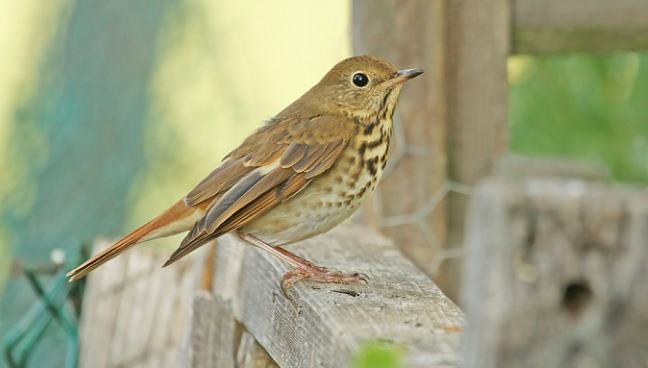
Hermit Thrush, Ryan Schain.
Continental Summary
A week of light to moderate movements in the southern half of the West featured Red-necked Grebe, Mew Gull, Hermit Thrush, Yellow-rumped Warbler, Townsend’s Warbler, and White-crowned Sparrow, while moderate to heavy flights in the East, particularly in the Upper Midwest, Appalachians, and central Plains, featured Cooper’s Hawk, American Coot, Yellow-bellied Sapsucker, Black-throated Blue Warbler, Eastern Towhee, Fox Sparrow, Swamp Sparrow, and White-crowned Sparrow.
Wondering what species are going to move this week? Check out our forecast for the next 7 days.
Need a review of our definitions for regions, species on the move, and migration amounts? Please visit this link.
Quick Links to Regions
Upper Midwest and Northeast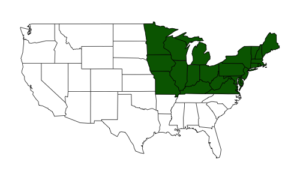 |
Gulf Coast and Southeast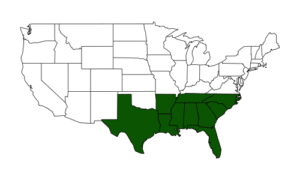 |
Great Plains |
West |
Upper Midwest and Northeast
Scattered moderate and local heavy flights occurred last weekend as low pressure finally departed from the region. With the departure of unsettled weather, the beginning of the work week featured more widespread light to moderate flights, with some locally heavier Virginia flights. Toward the middle of the week, more widespread moderate flights expanded to cover many areas, with some continued heavy flights in the Great Lakes region. In addition, many coastal areas experienced a prolonged period of northeasterly flow, bringing moderate flights to these areas for several days. However, much less favorable conditions ended the week, and Thursday night saw much reduced migration for most of the region away from the coastal fringe and Upper Mississippi River valley.
Top Movers
Increasing
| Species | Increase from Last Week | % of Checklists Reporting |
|---|---|---|
| Swamp Sparrow | 91% | 19.1 |
| Ruby-crowned Kinglet | 64% | 26.1 |
| Northern Mockingbird | 117% | 17 |
| Yellow-rumped Warbler | 58% | 41.1 |
| White-throated Sparrow | 52% | 31.5 |
| Song Sparrow | 53% | 43.4 |
| White-crowned Sparrow | 65% | 13.5 |
| Eastern Towhee | 81% | 16.5 |
| Golden-crowned Kinglet | 49% | 16.5 |
| Hermit Thrush | 94% | 8.1 |
| White-rumped Sandpiper | 224% | 2.6 |
| Red-winged Blackbird | 52% | 23.4 |
| Chipping Sparrow | 57% | 16.7 |
| Savannah Sparrow | 59% | 11.2 |
| Eastern Bluebird | 59% | 16.7 |
| Blue-headed Vireo | 78% | 8.3 |
| Dark-eyed Junco | 44% | 13.4 |
| Yellow-bellied Sapsucker | 53% | 12.4 |
| Field Sparrow | 54% | 7.3 |
| Fox Sparrow | 154% | 1.7 |
| Brown-headed Cowbird | 70% | 4.9 |
Decreasing
| Species | Decrease from Last Week | % of Checklists Reporting |
|---|---|---|
| Bay-breasted Warbler | -65% | 0.5 |
| Short-billed Dowitcher | -66% | 0.2 |
| American Redstart | -38% | 4.2 |
| Magnolia Warbler | -33% | 3.9 |
| Stilt Sandpiper | -55% | 0.3 |
| Chestnut-sided Warbler | -58% | 0.5 |
| Rose-breasted Grosbeak | -34% | 2.3 |
| Ruby-throated Hummingbird | -44% | 2.4 |
| Black-and-white Warbler | -33% | 2.6 |
| Northern Waterthrush | -50% | 0.6 |
| Snowy Egret | -24% | 2.5 |
| Osprey | -24% | 5.9 |
| Least Flycatcher | -82% | 0.1 |
| Hooded Warbler | -71% | 0.1 |
| Wood Thrush | -38% | 0.8 |
| Marbled Godwit | -73% | 0.1 |
| Mourning Warbler | -94% | 0 |
| Eastern Wood-Pewee | -23% | 3.5 |
| Yellow-throated Warbler | -76% | 0.1 |
| Wilson's Warbler | -46% | 0.3 |
| Northern Rough-winged Swallow | -45% | 1.5 |
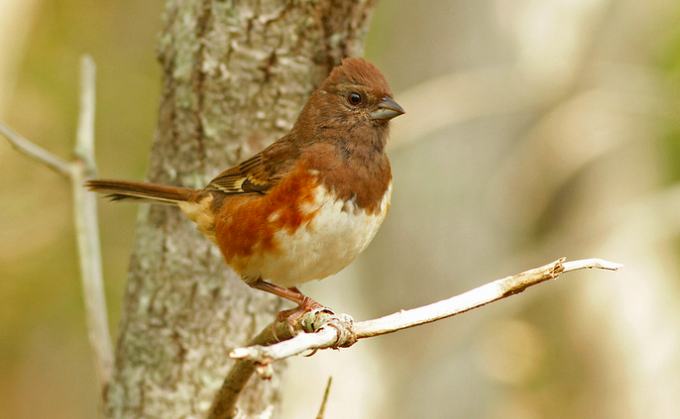
Eastern Towhee, Ian Davies
Gulf Coast and Southeast
Moderate and locally heavy flights occurred primarily west of the Alabama River drainage and scattered across Florida last weekend. Precipitation shut down flights in other areas, particularly in the southern Appalachians and southeastern coastal Plain. By Monday, heavier flights came to the Appalachians, and movements in the region generally became more eastern in their distribution. This pattern continued through the remainder of the period, as birds moved through the Appalachians, into the southeast, and out of Florida. By the end of the week, primarily light to locally moderate movements spanned the region.
Top Movers
Increasing
| Species | Increase from Last Week | % of Checklists Reporting |
|---|---|---|
| Yellow-bellied Sapsucker | 465% | 6.4 |
| Palm Warbler | 112% | 15.4 |
| Northern Flicker | 100% | 21.5 |
| Black-throated Blue Warbler | 308% | 5.3 |
| Gray Catbird | 41% | 28.3 |
| Yellow-rumped Warbler | 215% | 2.8 |
| Savannah Sparrow | 203% | 2.4 |
| Eastern Phoebe | 39% | 22.1 |
| Eastern Bluebird | 35% | 22.1 |
| Cape May Warbler | 522% | 3.2 |
| White-throated Sparrow | 1914% | 0.8 |
| Song Sparrow | 73% | 5.5 |
| Swamp Sparrow | 381% | 1.1 |
| Golden-crowned Kinglet | 771% | 0.9 |
| Ruby-crowned Kinglet | 47% | 7.9 |
| Gray-cheeked Thrush | 141% | 2.9 |
| Swainson's Thrush | 76% | 8.4 |
| Marsh Wren | 78% | 2.8 |
| Pine Warbler | 41% | 12 |
| Magnolia Warbler | 61% | 11.1 |
| Blue-headed Vireo | 166% | 2.6 |
| American Redstart | 60% | 19.3 |
| Bobolink | 99% | 1.7 |
Decreasing
| Species | Decrease from Last Week | % of Checklists Reporting |
|---|---|---|
| Wilson's Warbler | -47% | 1.6 |
| Yellow-bellied Flycatcher | -85% | 0.1 |
| Yellow Warbler | -42% | 2.7 |
| White-winged Dove | -31% | 7.8 |
| Warbling Vireo | -83% | 0.1 |
| Eastern Kingbird | -60% | 0.6 |
| Cattle Egret | -36% | 6.4 |
| Ruby-throated Hummingbird | -22% | 13.7 |
| Piping Plover | -47% | 0.8 |
| Blue-winged Teal | -33% | 5.3 |
| Prothonotary Warbler | -94% | 0 |
| Lark Sparrow | -39% | 0.9 |
| Black-bellied Plover | -28% | 3 |
| Red Knot | -54% | 0.3 |
| Black-chinned Hummingbird | -57% | 0.3 |
| Dickcissel | -45% | 0.7 |
| Marbled Godwit | -36% | 1 |

Cooper’s Hawk, Ian Davies
Great Plains
The Plains experienced local light to moderate migration for the first half of the period, including more extensive flights in the central Plains on Sunday night and the northern Plains on Monday night. The big change came on Tuesday night, when more extensive flights occurred across the region including heavy migration in the central Plains. Another large flight occurred to end the period on Thursday night, when heavy flights were aloft over the central and southern Plains. Note that some of these heavy flights were shut down by precipitation associated with a passing frontal boundary in Kansas.
Top Movers
Increasing
| Species | Increase from Last Week | % of Checklists Reporting |
|---|---|---|
| Greater White-fronted Goose | -1314% | 2 |
| Herring Gull | 891% | 2.2 |
| Fox Sparrow | 86% | 4.6 |
| Swamp Sparrow | 74% | 5.5 |
| Cooper's Hawk | 75% | 11.5 |
| Yellow-bellied Sapsucker | 32% | 7.2 |
| Brown Creeper | 56% | 4.6 |
| Baird's Sandpiper | 169% | 2.8 |
| Dark-eyed Junco | 30% | 15.3 |
| American Coot | 35% | 16.9 |
| Yellow-headed Blackbird | 206% | 1.9 |
| White-throated Sparrow | 20% | 16.7 |
| Marbled Godwit | 4644% | 0.9 |
| Winter Wren | 64% | 2 |
| Sanderling | 137% | 1.5 |
| Purple Finch | 52% | 2.4 |
| Sedge Wren | 31% | 5.7 |
| Harris's Sparrow | 34% | 5.1 |
| Black-bellied Plover | 92% | 1.4 |
| California Gull | 263% | 0.7 |
Decreasing
| Species | Decrease from Last Week | % of Checklists Reporting |
|---|---|---|
| Broad-winged Hawk | -99% | 0 |
| Summer Tanager | -76% | 1.1 |
| Eastern Wood-Pewee | -93% | 0.2 |
| Peregrine Falcon | -62% | 1.4 |
| Belted Kingfisher | -29% | 9.9 |
| Indigo Bunting | -35% | 4.4 |
| Bonaparte's Gull | -89% | 0.1 |
| Barn Swallow | -32% | 8.2 |
| Osprey | -27% | 7 |
| Caspian Tern | -86% | 0.1 |
| Wilson's Warbler | -55% | 0.7 |
| Scissor-tailed Flycatcher | -26% | 6.3 |
| Rose-breasted Grosbeak | -49% | 0.4 |
| Black-and-white Warbler | -96% | 0 |
| Swainson's Thrush | -66% | 0.5 |
| Warbling Vireo | -67% | 0.4 |
| House Wren | -19% | 10.5 |
| Northern Parula | -52% | 0.7 |
| Solitary Sandpiper | -93% | 0 |
| Green Heron | -60% | 0.7 |
| Common Yellowthroat | -26% | 6.4 |
| Northern Flicker | -13% | 40.8 |
| Yellow-billed Cuckoo | -38% | 1.5 |
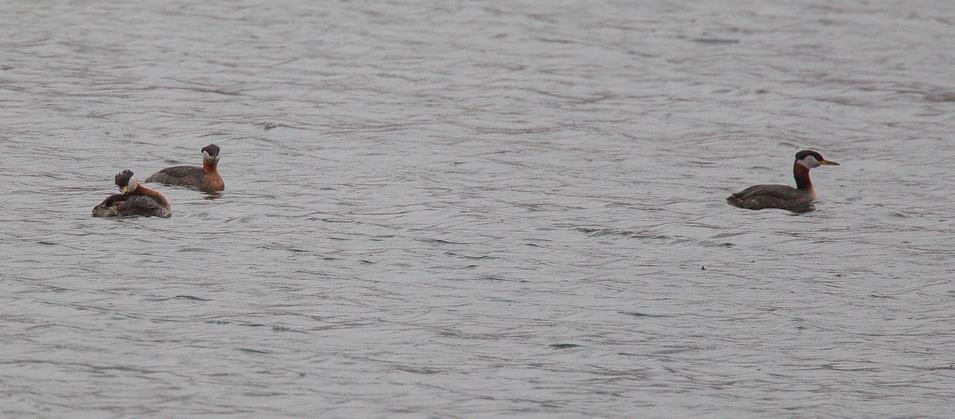
Red-necked Grebes, Chris Wood
West
The Central Valley of California and the Great Basin saw the primary action for the region this past week, as light to moderate flights their highlighted otherwise localized flights. Localized light to moderate flights continued through the middle of the week in many areas. But Wednesday night saw more extensive movements in the Desert Southwest, where similarly intense but slightly more extensive flights continued to end the period. Note that portions of the eastern front of the Rockies saw heavier flights to end the period, associated with large movements occurring in the favorable conditions in the Great Plains.
Top Movers
Increasing
| Species | Increase from Last Week | % of Checklists Reporting |
|---|---|---|
| Ruby-crowned Kinglet | 42% | 23 |
| Hermit Thrush | 41% | 6.3 |
| Mew Gull | 55% | 2.4 |
| Red-necked Grebe | 76% | 1.8 |
| Pine Siskin | 20% | 7.7 |
| Rough-legged Hawk | 143% | 0.5 |
| Northern Shrike | 312% | 0.4 |
| Yellow-rumped Warbler | 15% | 38.5 |
| Marbled Murrelet | 159% | 0.8 |
| Northern Mockingbird | 15% | 13.1 |
| Ruddy Turnstone | 71% | 1 |
| Franklin's Gull | 64% | 1.2 |
| Ring-necked Duck | 17% | 4.4 |
| White-crowned Sparrow | 13% | 39.9 |
| Arctic Tern | 62% | 0.7 |
| Northern Flicker | 10% | 39.1 |
| Black-throated Gray Warbler | 14% | 6 |
| Townsend's Warbler | 18% | 9.5 |
| Anna's Hummingbird | 11% | 28.2 |
| Thayer's Gull | 162% | 0.3 |
| Herring Gull | 23% | 2.1 |
| Black Phoebe | 14% | 28 |
Decreasing
| Species | Decrease from Last Week | % of Checklists Reporting |
|---|---|---|
| Vesper Sparrow | -37% | 1.4 |
| Black-chinned Hummingbird | -48% | 0.7 |
| Willow Flycatcher | -88% | 0.1 |
| Turkey Vulture | -26% | 15.6 |
| Lesser Yellowlegs | -36% | 0.9 |
| Swainson's Hawk | -31% | 1.2 |
| Yellow-green Vireo | -88% | 0 |
| Mountain Bluebird | -35% | 1.6 |
| Western Sandpiper | -29% | 2.2 |
| Bell's Vireo | -59% | 0.2 |
| Elegant Tern | -20% | 2.5 |
| Yellow Warbler | -16% | 6.4 |
| Lazuli Bunting | -52% | 0.3 |
| Barn Swallow | -22% | 5.4 |
| Swainson's Thrush | -34% | 0.8 |
–––––––––––––––––––––––––––––––––––
Farnsworth and Van Doren




